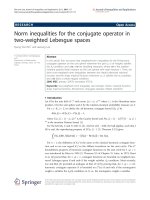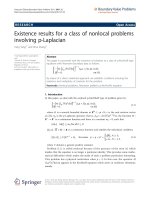Báo cáo hóa học: " Schur convexity for the ratios of the Hamy and generalized Hamy symmetric functions Wei-Mao Qian" docx
Bạn đang xem bản rút gọn của tài liệu. Xem và tải ngay bản đầy đủ của tài liệu tại đây (265.51 KB, 8 trang )
RESEARC H Open Access
Schur convexity for the ratios of the Hamy and
generalized Hamy symmetric functions
Wei-Mao Qian
Correspondence: qwm661977@126.
com
Huzhou Broadcast and TV
University, Huzhou 313000, China
Abstract
In this paper, we present the Schur convexity and monotonicity properties for the
ratios of the Hamy and generalized Hamy symmetric functions and establish some
analytic inequalities. The achieved results is inspired by the paper of Hara et al. [J.
Inequal. Appl. 2, 387-395, (1998)], and the methods from Guan [Math. Inequal. Appl.
9, 797-805, (2006)]. The inequalities we obtained improve the existing corresponding
results and, in some sense, are optimal.
2010 Mathematics Subject Classification: Primary 05E05; Secondary 26D20.
Keywords: Hamy symmetric function, generalized Hamy symmetric function, Schur
convex, Schur concave
1 Introduction
Throughout this paper, we denote
R
n
+
= {x =(x
1
, x
2
, , x
n
)|x
i
> 0, i =1,2, , n}
.
.For
x ∈ R
n
+
, the Hamy symmetric function [1] is defined as
F
n
(x, r)=F
n
(x
1
, x
2
, , x
n
; r)=
1≤i
1
<i
2
<···<i
r
≤n
⎛
⎝
r
j=1
x
i
j
⎞
⎠
1
r
,
(1:1)
where r is an integer and 1 ≤ r ≤ n.
The generalized Hamy symmetric function was introduced by Guan [2] as follows
F
∗
n
(x, r)=F
∗
n
(x
1
, x
2
, , x
n
; r)=
i
1
+i
2
+···+i
n
=r
x
i
1
1
x
i
2
2
x
i
n
n
1
r
,
(1:2)
where r is a positive integer.
In [2], Guan proved that both F
n
(x,r) and
F
∗
n
(x, r
)
are Schur concave in
R
n
+
. The main
of this paper is to investigate the Schur convexity for the functions
F
n
(x, r)
F
n
(
x, r − 1
)
and
F
∗
n
(x, r)
F
∗
n
(x, r − 1)
and establish some analytic inequalities by use of the theory of
majorization.
For convenience of readers, we recall some definitions as follows, which can be
found in many references, such as [3].
Qian Journal of Inequalities and Applications 2011, 2011:131
/>© 2011 Qian; licensee Springer. This is an Open Access article distributed under the terms of the Creative Commons Attribution
License ( which permits unrestricted use, distribution, and reproduction in any medium,
provided the original work is properly cited.
Definition 1.1.Then-t uple x is said to be majorized by the n-tuple y (in symbols
x ≺ y), if
k
i
=1
x
[i]
≤
k
i
=1
y
[i]
,
n
i
=1
x
[i]
=
n
i
=1
y
[i]
,
where 1 ≤ k ≤ n-1, and x
[i]
denotes the ith largest component of x.
Definition 1.2.LetE ⊆ ℝ
n
be a set. A real-value d function F : E ® ℝ is said to be
Schur convex on E if F(x) ≤ F(y)foreachpairofn-tuples x=(x
1
, , x
n
)andy=(y
1
, ,
y
n
)inE, such that x ≺ y. F is said to be Schur concave if -F is Schur convex.
The theory of Schur convexity is one of the most important theories in the fields of
inequalities. It can be used in combinatorial optimization [4], isoperimetric problems
for polytopes [5], theory of statistical experiments [6], graphs and matrices [7], gamma
functions [8], reliability and availability [9], optimal designs [10] and other related
fields.
Our aim in what follows is to prove the following results.
Theorem 1.1.Let
x ∈ R
n
+
,2 ≤ r ≤
n
is an integer, then the function
φ
r
(x)=
F
n
(x, r)
F
n
(
x, r − 1
)
is Schur concave in
R
n
+
and increasing with respect to x
i
(i=1,2, ,
n).
Theorem 1.2.Let
x ∈ R
n
+
,2 ≤ r ≤
n
is an integer, then the function
φ
∗
r
(x)=
F
∗
n
(x, r)
F
∗
n
(x, r − 1)
is Schur concave in
R
n
+
and increasing with respect to x
i
(i=1,2, n).
Corollary 1.1.If
x
i
> 0, i =1,2, , n,
n
i
=1
x
i
=
s
and that c ≥ s, then
G
n
(x)
G
n
(
c − x
)
=
F
n
(x, n)
F
n
(
c − x, n
)
≤
F
n
(x, n −1)
F
n
(
c − x, n − 1
)
≤···≤
F
n
(x,1)
F
n
(
c − x,1
)
=
A
n
(x)
A
n
(
c − x
)
and
G
n
(x)
G
n
(
c + x
)
=
F
n
(x, n)
F
n
(
c + x, n
)
≤
F
n
(x, n −1)
F
n
(
c + x, n −1
)
≤···≤
F
n
(x,1)
F
n
(
c + x,1
)
=
A
n
(x)
A
n
(
c + x
)
,
where
A
n
(x)=
1
n
n
i=1
x
i
, G
n
(x)=
n
i=1
x
i
1
n
are the arithmetic and geo-metric
means of x, respectively.
Corollary 1.2.If
x
i
> 0, i =1,2, , n,
n
i
=1
x
i
=
s
and that c ≥ s, then
F
∗
n
(x, r)
F
∗
n
(c − x, r)
≤
F
∗
n
(x, r − 1)
F
∗
n
(c − x, r − 1)
≤···≤
F
∗
n
(x,2)
F
∗
n
(c − x,2)
≤
F
∗
n
(x,1)
F
∗
n
(c − x,1)
=
A
n
(x)
A
n
(c − x)
and
F
∗
n
(x, r)
F
∗
n
(c + x, r)
≤
F
∗
n
(x, r − 1)
F
∗
n
(c + x, r − 1)
≤···≤
F
∗
n
(x,2)
F
∗
n
(c + x,2)
≤
F
∗
n
(x,1)
F
∗
n
(c + x,1)
=
A
n
(x)
A
n
(c + x)
.
2 Lemmas
In order to establish our main results, we need several lemmas, which we present in
this section.
Qian Journal of Inequalities and Applications 2011, 2011:131
/>Page 2 of 8
Lemma 2.1 ( see [3]). Let E ⊆ ℝ
n
be a symmetric convex set with nonempty interior
intE and : E ® ℝ be a continuous symmetric function. If is differentiable on intE,
then is Schur convex (or Schur concave, respectively) on E if and only if
(x
i
− x
j
)
∂ϕ
∂x
i
−
∂ϕ
∂x
j
≥ 0(or≤ 0, respectively
)
for all i,j = 1,2, ,n and x =(x
1
, ,x
n
) Î intE.
The rth elementary symmetric function (see [11]) is defined as
E
n
(x, r)=E
n
(x
1
, x
2
, , x
n
; r)=
1≤i
1
<i
2
<···<i
r
≤n
⎛
⎝
r
j=1
x
i
j
⎞
⎠
,
(2:1)
where 1 ≤ r ≤ n is a positive integer, and E
n
(x,0)=1.
By (2.1) and simple computations, we have the following lemma.
Lemma 2.2. Let
x ∈ R
n
+
,1≤ i ≤
n
,if
x
i
=
(
x
1
, x
2
, , x
i−1
, x
i+1
, , x
n
).
Then,
E
n
(
x
1
, x
2
, , x
n
; r
)
= x
i
E
n−1
(
x
i
, r − 1
)
+ E
n−1
(
x
i
, r
).
(2:2)
Lemma 2.3 (see [11]). Let
x ∈ R
n
+
,
r
is an integer and 1 ≤ r ≤ n-1.
Then,
(
E
n
(
x, r
))
2
> E
n
(
x, r − 1
)
E
n
(
x, r +1
).
(2:3)
Another important symmetric function is the complete symmetric function (see [3]),
which is defined by
C
r
(x)=C
r
(x
1
, x
2
, , x
n
)=
i
1
+i
2
+···+i
n
=r
x
i
1
1
x
i
2
2
x
i
n
n
,
where i
1
,i
2
, , i
n
are non-negative integer, r Î {1, 2, } and C
0
(x)=1.
Lemma 2.4 (see [12]). Let x
i
>0,i=1, 2, , n, and
x
i
=
(
x
1
, x
2
, , x
i−1
, x
i+1
, , x
n
)
.
Then,
C
r
(
x
)
= x
i
C
r−1
(
x
)
+ C
r
(
x
i
).
Lemma 2.5 (see [13]). If
0 < r < s, x ∈ R
n
+
, then
C
r
(
x
)
C
s−1
(
x
)
> C
r−1
C
s
(
x
).
Lemma 2.6 (see [14]). If
x
i
> 0, i =1,2, , n,
n
i
=1
x
i
=
s
and c ≥ s, then
(1)
c − x
nc
s
− 1
=
⎛
⎜
⎝
c − x
1
nc
s
− 1
,
c − x
2
nc
s
− 1
, ,
c − x
n
nc
s
− 1
⎞
⎟
⎠
≺ (x
1
, x
2
, , x
n
)=x
,
,
(2)
c + x
s
+
nc
=
c + x
1
s
+
nc
,
c + x
2
s
+
nc
, ,
c + x
n
s
+
nc
≺
x
1
s
,
x
2
s
, ,
x
n
s
=
x
s
.
3 Proof of Theorems
Proof of Theorem 1.1. It is obvious that j
r
(x) is symmetric and has continuous partial
derivatives in
R
n
+
. By Lemma 2.1, we only need to prove that
Qian Journal of Inequalities and Applications 2011, 2011:131
/>Page 3 of 8
(x
1
− x
2
)
∂φ
r
(x)
∂x
1
−
∂φ
r
(x)
∂x
2
≤ 0
.
(3:1)
For any fixed 2 ≤ r ≤ n,let
u
i
=
r
√
x
i
, i =1,2, ,
n
and
u
=(u
1
, u
2
, , u
n
) ∈ R
n
+
,we
have
φ
r
(x)=
F
n
(x, r)
F
n
(
x, r − 1
)
=
E
n
(u, r)
E
n
(
u, r − 1
)
.
Differentiating j
r
(x) with respect to x
1
yields
∂φ
r
(x)
∂x
1
=
1
E
2
n
(u, r − 1)
E
n
(u, r − 1)
∂E
n
(u, r)
∂u
1
∂u
1
∂x
1
− E
n
(u, r)
∂E
n
(u, r − 1)
∂u
1
∂u
1
∂x
1
.
(3:2)
Using Lemma 2.2 repeatedly, we get
E
n
(u, r)=u
1
u
2
E
n−2
(u
3
, , u
n
; r − 2) + (u
1
+ u
2
)E
n−2
(u
3
, , u
n
; r − 1
)
+ E
n−2
(
u
3
, , u
n
; r
)
.
(3:3)
Equations (3.2) and (3.3) lead to
∂φ
r
(x)
∂x
1
=
1
rE
2
n
(u, r − 1)
(u
1−r
1
u
2
A + u
1−r
1
B)
,
(3:4)
where
A = E
n
(
u, r − 1
)
E
n−2
(
u
3
, , u
n
; r − 2
)
− E
n
(
u, r
)
E
n−2
(
u
3
, , u
n
; r − 3
)
and
B = E
n
(
u, r − 1
)
E
n−2
(
u
3
, , u
n
; r − 1
)
− E
n
(
u, r
)
E
n−2
(
u
3
, , u
n
; r − 2
).
Similarly, we can deduce that
∂φ
r
(x)
∂x
2
=
1
rE
2
n
(u, r − 1)
(u
1
u
1−r
2
A + u
1−r
2
B)
.
(3:5)
From (3.4) and (3.5), one has
(x
1
− x
2
)
∂φ
r
(x)
∂x
1
−
∂φ
r
(x)
∂x
2
=
x
1
− x
2
rE
2
n
(u, r − 1)
⎡
⎢
⎣
x
1
r
1
x
1
r
2
(x
−1
1
− x
−1
2
)A +(x
1
r
−1
1
− x
1
r
−1
2
)B
⎤
⎥
⎦
.
(3:6)
It follows from (3.3) and Lemma 2.3 that
A =(u
1
+ u
2
)[E
2
n−2
(u
3
, , u
n
; r − 2) − E
n−2
(u
3
, , u
n
; r − 1)
× E
n−2
(u
3
, , u
n
; r − 3)] + E
n−2
(u
3
, , u
n
; r − 1)E
n−2
(u
3
, , u
n
; r − 2
)
− E
n−2
(u
3
, , u
n
; r)E
n−2
(u
3
, , u
n
; r − 3)
>
0.
Similarly, we can get B >0.
Qian Journal of Inequalities and Applications 2011, 2011:131
/>Page 4 of 8
It follows from the function
x
k − r
r
(
k =0,1
)
is decreasing in (0, +∞) that
(x
1
− x
2
)
⎛
⎜
⎝
x
k − r
r
1
− x
k − r
r
2
⎞
⎟
⎠
≤ 0, (k =0,1)
.
(3:7)
Therefore, inequality (3.1) follows from (3.6) and (3.7) together with A > 0 and B >0.
Next, we prove that
φ
r
(x)=
F
n
(x, r)
F
n
(
x, r − 1
)
is increasing with respect to x
i
(i=1,2, ,n).
By the symmetry of j
r
(x) with respect to x
i
(i=1, 2, , n), we only need to prove that
∂φ
r
(x)
∂x
1
≥ 0
,
which can be derived directly from A > 0 and B > 0 together with Equation (3.4).
Proof of Theorem 1.2. It is obvious that
φ
∗
r
(x
)
is symmetric and has continuous par-
tial derivatives in
R
n
+
. By Lemma 2.1, we only need to prove that
(x
1
− x
2
)
∂φ
∗
r
(x)
∂x
1
−
∂φ
∗
r
(x)
∂x
2
≤ 0
.
(3:8)
For any fixed 2 ≤ r ≤ n,let
u
i
=
r
√
x
i
, i =1,2, ,
n
and
u =(u
1
, u
2
, , u
n
) ∈ R
n
+
.
Then,
φ
∗
r
(x)=
F
∗
n
(x, r)
F
∗
n
(x, r − 1)
=
C
r
(u)
C
r−1
(u)
.
(3:9)
Differentiating
φ
∗
r
(x
)
with respect to x
1
, we have
∂φ
∗
r
(x)
∂x
1
=
1
C
2
r
−1
(u)
C
r−1
(u)
∂C
r
(u)
∂u
1
∂u
1
∂x
1
− C
r
(u)
∂C
r−1
(u)
∂u
1
∂u
1
∂x
1
.
(3:10)
It follows from Lemma 2.4 that
∂C
r
(
u
)
∂u
1
= C
r−1
(u)+u
1
∂C
r−1
(
u
)
∂u
1
= C
r−1
(u)+u
1
C
r−2
(u)+u
1
∂C
r−2
(u)
∂u
1
= C
r−1
(u)+u
1
C
r−2
(u)+u
2
1
∂C
r−2
(u)
∂u
1
= ······
= C
r−1
(u)+u
1
C
r−2
(u)+u
2
1
C
r−3
(u)+···+ u
r−2
1
C
1
(u)+u
r−1
1
.
(3:11)
Equations (3.10) and (3.11) lead to
∂φ
∗
r
(x)
∂x
1
=
1
C
2
r−1
(u)
[C
2
r−1
(u) − C
r
(u)C
r−2
(u)] + u
1
[C
r−1
(u)C
r−2
(u
)
− C
r
(u)C
r−3
(u)] + ···+ u
r−2
1
[C
r−1
(u)C
1
(u) − C
r
(u)C
0
(u)]
+C
r−1
(u)u
r−1
1
1
r
u
1−r
1
.
(3:12)
Qian Journal of Inequalities and Applications 2011, 2011:131
/>Page 5 of 8
Similarly, we have
∂φ
∗
r
(x)
∂x
2
=
1
C
2
r−1
(u)
{[C
2
r−1
(u) − C
r
(u)C
r−2
(u)] + u
2
[C
r−1
(u)C
r−2
(u
)
− C
r
(u)C
r−3
(u)] + ···+ u
r−2
2
[C
r−1
(u)C
1
(u) − C
r
(u)C
0
(u)]
+ C
r−1
(u)u
r−1
2
}
1
r
u
1−r
2
.
(3:13)
From (3.12) and (3.13), one has
(x
1
− x
2
)
∂φ
∗
r
(x)
∂x
1
−
∂φ
∗
r
(x)
∂x
2
=
x
1
− x
2
rC
2
r−1
(u)
⎧
⎪
⎨
⎪
⎩
[C
2
r−1
(u) − C
r
(u)C
r−2
(u)]
⎛
⎜
⎝
x
1 − r
r
1
− x
1 − r
r
2
⎞
⎟
⎠
+[C
r−1
(u)C
r−2
(u
)
− C
r
(u)C
r−3
(u)]
⎛
⎜
⎝
x
2 − r
r
1
− x
2 − r
r
2
⎞
⎟
⎠
+ ···+[C
r−1
(u)C
1
(u) − C
r
(u)C
0
(u)]
×
⎛
⎜
⎝
x
(r −1) − r
r
1
− x
(r −1) − r
r
2
⎞
⎟
⎠
⎫
⎪
⎬
⎪
⎭
.
(3:14)
By Lemma 2.5, we know that
C
2
r−1
(u) − C
r
(u)C
r−2
(u) > 0,
C
r−1
(u)C
r−2
(u) − C
r
(u)C
r−3
(u) > 0
,
······,
C
r−1
(
u
)
C
1
(
u
)
− C
r
(
u
)
C
0
(
u
)
> 0.
(3:15)
The monotonicity of th e function
x
j − r
r
(
1 ≤ j ≤ r −1
)
in (0, +∞)leadstothecon-
clusion that
(x
1
− x
2
)(x
j
− r
r
1
− x
j
− r
r
2
) ≤ 0
.
(3:16)
Therefore, inequality (3.8) follows from (3.14)-(3.16).
Next, we prove that
φ
∗
r
(x)=
F
∗
n
(x, r)
F
∗
n
(x, r − 1)
is increasing with respect to x
i
(i=1,2, ,n).
From (3.12) and (3.15), we clearly see that
∂φ
∗
r
(x)
∂x
1
≥ 0
.
(3:17)
Inequality (3.17) implies that
φ
∗
r
(x
)
is increasing with respect to x
1
, then from the
symmetry of
φ
∗
r
(x)
with respect to x
i
(i=1, 2, , n)weknowthat
φ
∗
r
(x
)
is increasing
with respect to each x
i
(i=1, 2, , n).
Proof of Corollary 1.1. By Theorem 1.1 and Lemma 2.6, we have
φ
r
⎛
⎜
⎝
c − x
nc
s
− 1
⎞
⎟
⎠
≥ φ
r
(x
)
and
φ
r
c + x
s
+
nc
≥ φ
r
x
s
which imply Corollary 1.1.
Qian Journal of Inequalities and Applications 2011, 2011:131
/>Page 6 of 8
Remark 1. Let
0 < x
i
≤
1
2
, i =1,2, ,
n
, then
G
n
(x)
G
n
(
1 − x
)
≤
A
n
(x)
A
n
(
1 − x
)
,
(3:18)
where (1 -x) = (1 -x
1
,1-x
2
, ,1-x
n
), commonly referred to as Ky Fan inequality
(see [15]), which has attracted the attention of a considerable number of mathemati-
cians (see [16-20]).
Letting
n
i
=1
x
i
≤
1
and taking c = 1 in Corollary 1.1, we get
G
n
(x)
G
n
(
1 − x
)
=
F
n
(x, n)
F
n
(
1 − x, n
)
≤
F
n
(x, n − 1)
F
n
(
1 − x, n − 1
)
≤···≤
F
n
(x,1)
F
n
(
1 − x,1
)
=
A
n
(x)
A
n
(
1 − x
)
.
(3:19)
It is obvious that inequality (3.19) can be called Ky Fan-type inequality.
Remark 2. Let x
i
>0,i=1, 2, , n, the following inequalities
n
i
=1
(x
−1
i
− 1) ≥ (n − 1)
n
and
n
i
=1
(x
−1
i
+1)≥ (n +1)
n
are the well-known Weierstrass inequalities (see [11]).
Taking c = s=1 in Corollary 1.1, one has
n
i=1
(x
−1
i
− 1) ≥
F
n
(1 − x , n −1)
F
n
(x, n −1)
n
≥···≥
F
n
(1 − x ,2)
F
n
(x,2)
n
≥ (n − 1)
n
and
n
i
=1
(x
−1
i
+1)≥
F
n
(1 + x , n −1)
F
n
(x, n −1)
n
≥···≥
F
n
(1 + x ,2)
F
n
(x,2)
n
≥ (n +1)
n
.
It is obvious that our inequalities can be called Weierstrass-type inequalities.
Proof of Corollary 1.2. By Theorem 1.2 and Lemma 2.6, we have
φ
∗
r
⎛
⎜
⎝
c − x
nc
s
− 1
⎞
⎟
⎠
≥ φ
∗
r
(x
)
and
φ
∗
r
c + x
s
+
nc
≥ φ
∗
r
x
s
, which imply Corollary 1.2.
Acknowledgements
This work was supported by NSF of China under grant No. 11071069.
Competing interests
The author declares that he has no competing interests.
Received: 22 February 2011 Accepted: 5 December 2011 Published: 5 December 2011
References
1. Hara, T, Uchiyama, M, Takahasi, S: A refinement of various mean in-equalities. J Inequal Appl. 2(4), 387–395 (1998)
2. Guan, KZ: The Hamy symmetric function and its generalization. Math Inequal Appl. 9(4), 797–805 (2006)
3. Marshall, AW, Olkin, I: Inequalities: Theorey of Majorization and Its Applications. Academic Press, New York (1979)
4. Hwang, FK, Rothblum, UG: Partition-optimization with Schur convex sum objective functions. SIAM J Discret Math. 18,
512–524 (2004). doi:10.1137/S0895480198347167
Qian Journal of Inequalities and Applications 2011, 2011:131
/>Page 7 of 8
5. Zhang, XM: Schur-convex functions and isoperimetric inequalities. Proc Am Math Soc. 126(2), 461–470 (1998).
doi:10.1090/S0002-9939-98-04151-3
6. Stepniak, C: Stochastic ordering and Schur-convex functions in comparison of linear experiments. Metrika. 36(5),
291–298 (1989)
7. Constantine, GM: Schur convex functions on spectra of graphs. Discret Math. 45(2-3), 181–188 (1983). doi:10.1016/0012-
365X(83)90034-1
8. Merkle, M: Convexity, Schur-convexity and bounds for the gamma function involving the digamma function. Rocky
Mountain J Math. 28(3), 1053–1066 (1998). doi:10.1216/rmjm/1181071755
9. Hwang, FK, Rothblum, UG, Shepp, L: Monotone optimal multipartitions using Schur convexity with respect to partial
orders. SIAM J Discret Math. 6(4), 533–547 (1993). doi:10.1137/0406042
10. Chan, NN: Schur-convexity for A-optimal designs. J Math Anal Appl. 122(1), 1–6 (1987). doi:10.1016/0022-247X(87)90339-
8
11. Bullen, PS: Handbook Of Means And Their Inequalities. Kluwer Academic Publishers Group, Dordrecht (2003)
12. Guan, KZ: Schur-convexity of the complete symmetric function. Math Inequal Appl. 9(4), 567–576 (2006)
13. Menon, KV: Inequalities for symmetric functions. Duke Math J. 35,37–45 (1968). doi:10.1215/S0012-7094-68-03504-7
14. Shi, HN: Refinement and generalization of a class of inequalities for symmetric functions. (Chinese) Math Pract Theory.
29(4), 81–84 (1999)
15. Beckenbach, EF, Bellman, R: Inequalities. Springer, New York (1965)
16. Alzer, H: On an inequality of Ky Fan. J Math Anal Appl. 137(1), 168–172 (1989). doi:10.1016/0022-247X(89)90280-1
17. Alzer, H: The inequality of Ky Fan and related results. Acta Appl Math. 38(3), 305–354 (1995). doi:10.1007/BF00996150
18. Neuman, E, Sándor, J: On the Ky Fan inequality and related inequalities. II Bull Aust Math Soc. 72(1), 87–107 (2005).
doi:10.1017/S0004972700034894
19. Govedarica, V, Jovanović, M: On the inequalities of Ky Fan, Wang-Wang and Alzer. J Math Anal Appl. 270(2), 709–712
(2002). doi:10.1016/S0022-247X(02)00074-4
20. Dragomir, SS, Scarmozzino, FP: On the Ky Fan inequality. J Math Anal Appl. 269(1), 129–136 (2002). doi:10.1016/S0022-
247X(02)00009-4
doi:10.1186/1029-242X-2011-131
Cite this article as: Qian: Schur convexity for the ratios of the Hamy and generalized Hamy symmetric functions.
Journal of Inequalities and Applications 2011 2011:131.
Submit your manuscript to a
journal and benefi t from:
7 Convenient online submission
7 Rigorous peer review
7 Immediate publication on acceptance
7 Open access: articles freely available online
7 High visibility within the fi eld
7 Retaining the copyright to your article
Submit your next manuscript at 7 springeropen.com
Qian Journal of Inequalities and Applications 2011, 2011:131
/>Page 8 of 8









